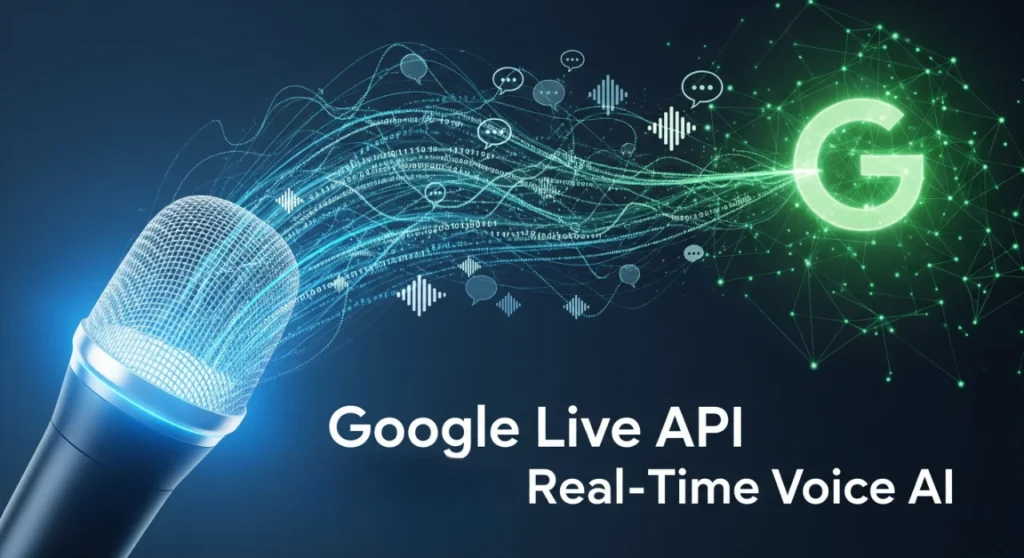AI chat is evolving from clunky text to smooth, real-time voice. Google’s new Live API, built on Gemini, brings us closer to natural conversations with machines—redefining how we’ll interact with apps, assistants, and even our cars.
Google’s Live API: The Future of Voice-First AI Has Arrived
In a major leap for real-time artificial intelligence, Google has officially launched its Live API, a groundbreaking tool that transforms the way we interact with machines. Powered by Gemini and unveiled at I/O 2025, this isn’t just another chatbot upgrade—it’s the beginning of a new interface revolution where spoken language takes center stage.
Forget the old, clunky back-and-forth of typing into a screen. With the Live API’s native audio-to-audio capabilities, you can talk to your AI in real time—and it talks back. Naturally. Smoothly. Like a human.
And that shift? It changes everything.
Key Takeaways:
- Voice is now the primary interface—more intuitive and faster than typing.
- Real-time dialogue with Gemini makes AI feel more like a person, not a tool.
- New use cases like in-car assistants, pair programming, and voice-first tutoring are already live.
- Proactive audio + emotion detection adds empathy and timing to conversations.
- Async tools + URL context make the API a powerful research and automation agent.
A New Era: Talking With AI, Not At It
Humans have always been wired for speech. We talk before we type, and we listen better than we read. Google’s team understood this deeply when designing the Live API—which explains why the product feels so… human.
Initially, the system worked as a “half-cascade” model: users spoke, the AI listened and replied with text-to-speech. That alone turned heads, especially when paired with viral features like screen sharing, where Gemini could literally see and understand your device in real-time.
But the new update goes a step further: native audio output. This means your AI now sounds natural—less robotic, more responsive. Real conversations, not canned responses.

Features That Make It Feel Alive
The technical leap is supported by some clever engineering under the hood:
- Proactive Audio: The model now knows when to speak. It avoids awkward interruptions, waiting for emotional or contextual cues.
- Sentiment Awareness: If you sound stressed or confused, the AI adjusts its tone and response accordingly—mirroring the empathy of a real human.
- “Thinking” Mode: Developers are testing a feature where the AI pauses briefly to process before responding—simulating thoughtful, considered replies.
It’s this kind of nuance that elevates the Live API from a cool tool to a revolutionary interface.
It’s Not Just Voice—It’s a Platform
Beyond just chit-chat, Google has added serious firepower for developers:
- URL Context Tool: Feed it links, and it can read, understand, and talk about what’s on those pages. Great for research bots or personalized news assistants.
- Async Function Calling: Need the AI to fetch info while you keep talking? No problem. The background task keeps things seamless.
- Composable Tools: Use search to find links, feed them to URL context, then ask for a voice summary. The API connects it all like digital Lego bricks.
Real-World Use Cases Already in Play
What’s truly exciting is how quickly developers are building futuristic experiences:
- Learning Tutors: From language practice to interactive studying, AI is now a conversational coach.
- Software Co-Pilots: Live screen understanding means apps like Photoshop can now come with a helpful AI tutor guiding your workflow.
- In-Car Companions: AI that warns you if you forget your keys or gives updates during your drive—no more stiff voice commands.
- Recruiting + Research Assistants: Conduct live interviews, record answers, and analyze data all in one go.
This isn’t science fiction. It’s already shipping.
Still Some Hurdles Ahead
No revolution comes without challenges. Google’s dev team is still working on:
- Turn Detection: Knowing exactly when a user has stopped speaking remains tricky.
- Latency + Session Limits: Ongoing improvements aim to keep responses fast and uninterrupted.
- Hallucinations: Like all large language models, Gemini isn’t immune to generating false facts—though new controls are helping mitigate that risk.
And in the pipeline? A feature called Proactive Video, where AI not only hears and speaks but sees—identifying real-world objects in video streams.
Imagine an AI helping you find your lost keys by literally watching the room with you.
Conclusion: A New Interface for the AI Age
Text boxes were a bridge. But the future? It’s voice-first, context-aware, and deeply human.
Google’s Live API is setting the bar for what the next wave of apps will look like—apps you don’t just click and type into, but apps you talk to, collaborate with, and trust.
For developers, startups, and creatives, this isn’t just an upgrade. It’s a call to build.
